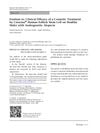
Search
for
Sort by
Research
240-270 / 1000+ results

research Comparative Study to Evaluate Tolerability of Topical 5% Minoxidil Novel Formulation and Alcohol-Based Conventional Solutions in Treatment of Androgenetic Alopecia in Indian Men: Randomized Double-Blind Study
New 5% minoxidil solution improves scalp hydration, reduces redness, and may be safer for sensitive users.

research Erratum to: Clinical Efficacy of a Cosmetic Treatment by Crescina Human Follicle Stem Cell on Healthy Males with Androgenetic Alopecia
Crescina treatment improves hair resistance and reduces hair loss.

research Liposomal Systems as Drug Delivery Vehicles for Dermal and Transdermal Applications
Liposomal systems show promise for delivering drugs through the skin but face challenges like high costs and stability issues.

research The Role of Androgen and Androgen Receptor in Skin-Related Disorders
Targeting androgen receptors could be a promising way to treat skin disorders with fewer side effects.

research Quality of Life Assessment in Male Patients with Androgenetic Alopecia: Results of a Prospective, Multicenter Study
Men with hair loss experience lower quality of life, worsened by factors like age, severity, and treatment history.

research Hair Growth Promoting Activity of Eclipta Alba in Male Albino Rats
Eclipta alba extract helps hair grow faster and more effectively than minoxidil in rats.

research Histological Features of Peripilar Signs Associated with Androgenetic Alopecia
Peripilar signs can help diagnose androgenetic alopecia and reveal its cause.

research Dermatoses of Pregnancy: Clues to Diagnosis, Fetal Risk, and Therapy
The document concludes that specific itchy skin diseases during pregnancy have varying fetal risks and treatments, including corticosteroids and other medications.

research Mutant Laboratory Mice With Abnormalities in Hair Follicle Morphogenesis, Cycling, and Structure: Annotated Tables
Mutant mice help researchers understand hair growth and related genetic factors.

research Analysis of Serum Zinc and Copper Concentrations in Hair Loss
People with hair loss, especially those with certain types, have lower zinc levels, and zinc supplements might help.

research Trans-Species Hair Growth Induction by Human Hair Follicle Dermal Papillae
Human hair follicle cells can grow hair when put into mouse skin if they stay in contact with mouse cells.

research The Therapeutic Effect and Changed Serum Zinc Level After Zinc Supplementation in Alopecia Areata Patients with Low Serum Zinc Level
Zinc supplements increased zinc levels in some hair loss patients but didn't significantly improve hair growth.

research Peroxisome Proliferator-Activated Receptors (PPARs) and PPAR Agonists: The Future in Dermatology Therapeutics?
PPAR agonists show promise for skin conditions but need more research before being a main treatment.

research Effects of Epidermal Growth Factor, Fibroblast Growth Factor, Minoxidil, and Hydrocortisone on Growth Kinetics in Human Hair Bulb Papilla Cells and Root Sheath Fibroblasts Cultured In Vitro
EGF and FGF boost hair cell growth, hydrocortisone slows it, and minoxidil doesn't affect it.

research Murine Skin as a Target for Melatonin Bioregulation
Melatonin affects mouse skin and may regulate skin functions.

research Repeated Microneedle Stimulation Induces Enhanced Hair Growth in a Murine Model
Microneedle stimulation can increase hair growth in mice.

research Functional Analysis of the Stratum Corneum of Scalp Skin: Studies in Patients with Alopecia Areata and Androgenetic Alopecia
Scalp skin barrier affects hair loss; personalized treatments needed.

research Successful Treatment of Alopecia Areata with Topical Calcipotriol
A boy with alopecia regrew hair using a vitamin D cream after other treatments failed.

research Characteristics of Androgenetic Alopecia in Asian Populations
Asian hair loss differs from Europeans; consider individual needs and psychological well-being for treatment.

research What Controls Hair Follicle Cycling?
The control system for hair growth cycles is not well understood and needs more research.

research Duration of Wrinkle Correction Following Repeat Treatment with Juvéderm Hyaluronic Acid Fillers
Juvéderm fillers effectively reduce wrinkles for up to 21 months with less filler needed for repeat treatments.

research Role of Androgens in Female-Pattern Androgenetic Alopecia, Either Alone or Associated with Other Symptoms of Hyperandrogenism
Androgens significantly affect female hair loss, and hormonal treatments may help.

research Influence of Substance P on Cultured Sebocytes
Substance P may worsen acne by increasing inflammation, but corticosteroids might help by reducing this effect.

research Dermoscopic Approach to a Small Round to Oval Hairless Patch on the Scalp
Dermoscopic examination helps diagnose different types of hair loss conditions by showing specific patterns.

research 5α-Reductase Activity in the Human Hair Follicle Concentrates in the Dermal Papilla
The enzyme that changes testosterone to a stronger form is mostly found in the part of the hair follicle called the dermal papilla.

research Recently Identified Forms of Epidermolysis Bullosa
Three new types of a skin blistering disease were found, caused by specific gene mutations.

research A Cell-Based System for Screening Hair Growth-Promoting Agents
Apigenin may help promote hair growth and could treat hair loss.

research Animal Models of Androgen-Dependent Disorders of the Pilosebaceous Apparatus
Testosterone causes hair loss in AGA mice, which are good for testing baldness treatments, and both minoxidil and cyproterone acetate can prevent this hair loss.

research Topical ALA-Photodynamic Therapy for Acne Can Induce Apoptosis of Sebocytes and Down-Regulate Their TLR-2 and TLR-4 Expression
ALA-photodynamic therapy helps reduce acne by causing acne cell death and lowering certain skin protein levels.